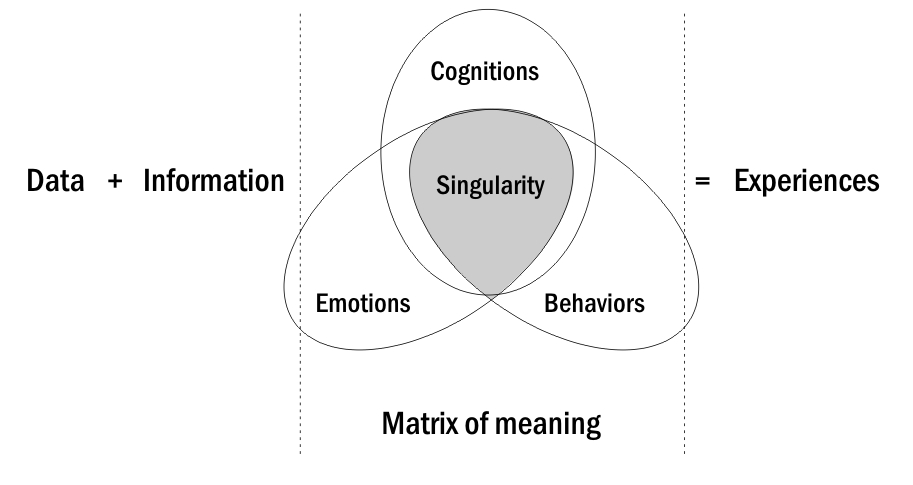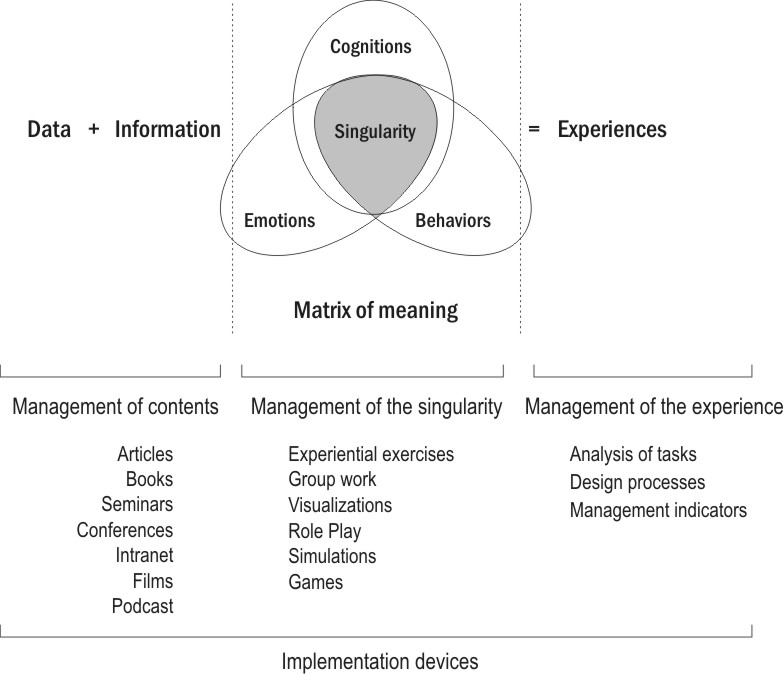Hack:
Creating contexts for personal development. The management of experiences
Human systems are symbolic systems (as opposed to mechanical systems and organic systems). Human structures are integrated from a purpose that gives "meaning" to their daily activities. Emotions are an essential factor in the everyday experiences that define the commitment to that purpose.
The deployment of human talent is related to the management of personal experiences a particular organizational context. This means: a purpose + emotions. This equation is the foundation of development of human talent, beyond models, technologies and tools.
The challenge we propose is "how to manage this equation (purpose + emotions) in organizations" to enhance human talent and provide an environment for people development.
The management of emotional states
People build their reality as a puzzle of thoughts and emotions. This puzzle arises from subjective interpretations which give shape and meaning to everyday events. The landscape we face daily is a picture created by symbols, ideas, and emotions that are supported by neural networks connected by chemical components that define the "color" of the interpretations and meaning. Emotions regulate behavior through chemical discharges that emerge as responses to the experiences of certain facts. All living systems, from unicellular to social, respond to context changes. But in people, these responses are mediated by the subjective experience of events. In other words, the characteristics of the context are based on our personal interpretation, which more or less is connected with reality and facts. Interpretations define a meaning which is colored emotionally by certain molecules. This combination of chemistry and meaning defines the way each person experiences everyday events.
Our experiences are not neutral images of events; they are internal representations which depend on two processes, one chemical and the other symbolic. Chemical discharges define emotions that mark the experiences and determine levels of anxiety, excitement, fear, empathy, joy, sadness, etc. that we experience in different situations. Moreover, the symbolic structure defines interpretations, and sets the meaning (positive or negative) of experiences. In this framework, we could describe the components of experiences by the following formula:

Experiences define a map of our context delimited by emotions and thoughts (chemistry and meaning). We live in a reality mediated by perceptions that generate maps of our everyday experiences. This map is a subjective representation of context characteristics. Ultimately, we all live within a subjective representation of reality and relate to a "personal version of events."

Our daily maps are generated in two dimensions of experience:
- Perception of context is related to a person's projections of possibilities of development that provides the context. The context can be seen optimistically as a stimulating space for personal opportunities and development options. But contextual conditions can also be perceived as a restricted space with limitations and threats to personal growth.
- Response mode is related to a person's attitude toward context characteristics. People may have a more reflective approach to contextual conditions based on analytical choices, seeking a broader impact in the context and long-term results. Or they may have a more reactive approach based on emotional choices, seeking a rapid stabilization of the subjective impact and results in the short term.
Perceptions of context and personal response together generate four emotional states, temporary positions that people assume when facing the characteristics of context. Each position synthesizes the relationship between chemistry and meaning and is reflected in specific modes of behavior, as shown in the following matrix.
These states are dynamic because they depend on changes in personal perceptions of the context and the person's attitude and choices. In this sense, we can describe the emotional states in four formulas:
- Vulnerable = Restricted context + Reactive response. From this emotional position, the context is experienced as hostile and threatening. People feel they have no chance of transforming their reality. Therefore, they have a sense of permanent failure and try to avoid or flee from anything new. Their choices are focused on refuge from hostility to protect themselves and maintain survival conditions.
- Defensive = Reflective response ˗ Restricted Context. In this position, people have an attitude of transformation and change, but from the perspective of threatening context. Therefore, their choices are focused on maintaining control of the context to fend off the obstacles hampering their development. A disturbance is perceived as an enemy to be controlled. People seek to maintain the conditions of their context in controlled levels.
- Adaptable = Stimulating context ˗ Reactive response. From this position, people have an open view about the possibilities of the context, understand its dynamics, and accept "the rules". However they also feel their choices are limited to trying to get the immediate benefits of the system while seeking emotional stability in the face of change. They are focused on the short term and they mobilize when they feel their stability is threatened.
- Purposeful = Stimulating context + Reflective response. In this position, people have a positive outlook about their future experiences and development alternatives. They see the future as an opportunity for transformation. This perspective leads them to create initiatives and engage with new development alternatives, because they feel their movements and decisions influence the course of events.
The heart of the problem is focused on the relationship between personality characteristics and environment characteristics. Each of the four states involves different personality traits that are enhanced or inhibited in relation to the dynamics of specific contexts.
Transform the experiences in organizations
Our reality is a landscape drawn with beliefs and colored with emotions. In the case of organizations, we have a relationship with an image of the organization. Personal experiences, in organizations, have other conditions and limitations related to the internal structure of the organization and the rules that define roles and modes of relationship in that shared space. The purpose of integrating emotions in performance processes is to support the responsiveness of people facing the challenges of the context in their organizations.
We can use the model of "emotional states" to transform corporate experiences and provide a more dynamic response to a human group. In this framework, we propose two levels of intervention: a global intervention, to create favorable context for development (related interventions in the system) and a personal intervention, to reframe specific emotional states (related to addressing the individual emotional positions).
Create favorable context for the development in the organization
For the design of favorable development contexts, we use the key features of emotional states to establish a shared map of positive conditions in the organization. The core characteristics are described in the following matrix.
These four core features of emotional states provide four parameters of intervention to create shared conditions in the system:
- Establish clear rules. This point is related to organizational purpose. Vulnerability is instilled with a sense of threat or danger. In order to transform vulnerability to determination, it is necessary for people to be clear about the goals of the organization and the "rules of relationships" in the system. This requires individuals to a) communicate, share, and sustain a clear picture of the strategic direction; b) manage the integration of people in a shared project; c) maintain a conceptual framework for the movements of the context; and d) design responses and ways to adapt to changes.
- Hold symmetrical relationships. This point is related to linkages in organizations. Emotional capital is critical for performance, to encourage participation and cooperation in groups. The quality of relationships determines the level of trust, security, and cooperation of the people. In this regard, it is important to a) strengthen diversity and the integration of heterogeneous points of view (professions, gender, age, philosophies, etc.); b) create an environment of respect and shared learning to hold the symmetry of relations; and c) maintain a solid emotional capital and a clean working atmosphere. These factors enrich the performance of teams and give them more resources for responding to the demands of the context.
- Define a transcendent purpose. This point is related to the meaning of work that people assume. The greater the significance of personal contribution, the greater the level of commitment and creativity in the task. To develop this, it is necessary to a) set meaningful goals to achieve new areas of development; b) generate innovative solutions to address everyday challenges; and c) recognize the participation and contribution of people in the development of corporate purpose.
- Promote transformation roles. This point refers to the interdependence of people and the social impact of individual behaviors. Each person can contribute significantly to the transformation of others. To maintain the importance of people as agents of change it is necessary to a) expand personal leadership and knowledge sharing; b) broaden participation and commitment to different social groups; and c) define long-term goals and objectives of social transcendence in everyday acts.
Reframe specific emotional positions
In this second point, to intervene in individual emotional positions, we propose to reconfigure the relationship of the components of each formula of emotional states to address the impact of particular individual behaviors. The model of emotional states provides four parameters of intervention to address personal experiences in the organization:
According to the formula developed above, to change the map it is necessary to intervene in the subjective experiences that define the image of the context or organization. To change the map, we must transform the experience. This process involves two movements: 1) reframe the interpretations (meaning); and 2) redefine the quality of emotions (chemistry). These movements correspond to both components in the formula of experiences.
The management of experiences
Both individually and personally, the context of transformation of experiences is always symbolic. Human systems are symbolic systems that have three entrances: cognitive, emotional, and behavioral. Based on these three factors can design a set of interventions to manage experiences.

Reframe the interpretations
- Clarify the shared contents: This means making sense of everyday activities and being clear about the reasons and justifications of corporate movements (external and internal). Many of an organization's decisions are bureaucratic responses that do not make sense within the demands and requirements of a specific context.
- Create spaces for communication. This means managing meanings that are circulating within the system. This can involve physical space as well as the opportunity to explain, listen, and refine message contents order to ensure that people integrate the correct meaning of the message. Often organizations only transmit isolated ideas, which generate confusion, poor performance, and deterioration in personal relationships.
Redefine the quality of emotions
- Clean processes: Coordinate actions with clear objectives to guide the performance of individuals. Many daily tasks are fragmented and do not respond to transcendent goals. Fragmentation and inconsistencies in the process decrease the responsiveness of organizations and teams.
- Care for the quality of relationships: Care for the impact of emotions. The working environment is one of the most important factors of performance and associated labor expense. Many relationships are framed under the pressure, generating deterioration of trust and cooperation.
The failure of nonsense
The management of daily life is related to the ability to create new realities, with the capacity to explore possibilities and design future alternatives in the present. The experience comes to processing data and information from certain cognitions and emotions. The singularity of an experience arises from a structure of meaning, from which interprets and defines a personal version of events.

According to these model, we could point out some basic aspects that define some important challenges in managing experiences:
- People lives into a symbolic network that defines their space and time and constitute the framework for their actions.
- The present is a place defined by subjective meanings, as a contact interface between perceived reality and the dynamics of context.
- The future is folding in decisions of the present and constitutes the framework for exploration that allows the design of alternatives.
- The change is an experience between the uncertainty and action, that involves abandoning the known to move into the unknown.
Based on these challenges, the management of the experiences involves cognitive processes (management and integration of data and information), emotional states (for handling feelings aroused by the process) and historical behaviors (to articulate the experiences of the present toward the past and the future).
Three levels of management
The most common mistake in the management of experiences is to transmit data and information mechanically ignoring the singularities that generate different experiences. Thus, the message becomes meaningless and the experience is reduced to a set of bureaucratic processes. In order to effective in human systems we must work with the singularities (cognitive, emotional and historical), that generates a particular experience.
The meaning matrix is used as a platform for articulate data and information and manages group and personal experiences in three steps:
- Contents management: provide theories and methodologies that can enhance information and knowledge related to each of the topics. This is a rational level of reporting and access to technical and theoretical material.
-
Management of singularity: work on the dynamics of subjective integration of content that define the singularity of the experience. This is a rational and emotional level where documents are complemented with exercises, simulations and role plays for the management of the singularity. This step is divides into three stages:
- Cognitive integration: to generate a conceptual understanding of each of the training topics, share ideas, discuss and compare.
- Emotional integration: to deal with feelings and positive emotions and / or negative that appear with these new contents.
- Behavioral integration: to analyze the possibilities and difficulties to develop new practices and to keep certain habits.
- Management of the experience: this is the end of the process where the previous steps are integrated in the definition of new behaviors and attitudes.
Various means and devices are applied for managing each of the stages.




You need to register in order to submit a comment.